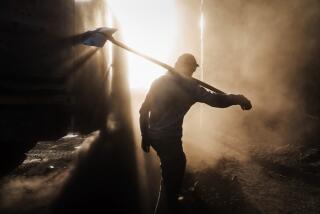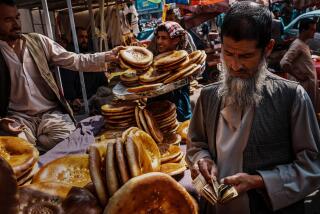South is key in Afghan campaign
- Share via
WASHINGTON — Although the U.S. military campaign so far has focused heavily on northern Afghanistan, the United States has little hope of tracking Osama bin Laden, eliminating his al-Qaida terrorist network or replacing the Taliban regime unless it wins in the south -- the cradle of Afghan power, according to U.S. and regional experts.
Bin Laden is believed to be hiding in the south. It is the stronghold of the Taliban. And it is where the Pushtuns, Afghanistan’s largest ethnic faction, are dominant.
And unlike in the north -- where the U.S. strategy is to rely on massive airstrikes, opposition Northern Alliance troops and small units of U.S. Special Forces -- winning over the south may require major U.S. offensives, including ground troops, the analysts warn. “To take the south, the United States will have to wage a ground war,” said Olivier Roy, an expert on Afghanistan at the National Center for Scientific Research in Paris. “The only way to get rid of the Taliban is a ground war.”
Any prospect of finding bin Laden, the suspected mastermind of the Sept. 11 terrorist attacks on the United States, will require penetrating the south, the experts agree. He and other al-Qaida leaders have a well-established network of cave hide-outs and underground tunnels in the region, according to Pakistani and U.S. sources.
“Bin Laden, protected by al-Qaida, is making his last stand there, and unless the Taliban decides to surrender him, the only way to get him will require a serious military commitment in the south,” said a former intelligence analyst specializing in South Asia.
He added: “Before you can declare victory, you have to be sure that the south has been emptied of these people. And frankly, no one is really sure how many there are. It’s something you’ll only know once you’re there.”
The south is also the stronghold and ideological center of the Taliban. Mullah Mohammed Omar, the Taliban leader, operates from the desert city of Kandahar, rather than Kabul, Afghanistan’s mountainous capital and ethnic melting pot once famous for its cool climate, cosmopolitan culture and bustling trade.
Cracking the Taliban’s hold will require taking the south, not just the nation’s major cities, the experts say. Opposition forces could take urban areas -- such as Jalalabad, Herat, even Kabul -- and then find themselves trapped and under sporadic attack from Taliban forces who disappear into the countryside, warned Kenneth M. Pollack, a former staff member of the National Security Council now at the Council on Foreign Relations think tank.
That challenge ultimately forced the Soviet Union to pull out its troops more than a decade ago.
The Taliban’s hold on the south is buttressed by a vast support network straddling the Pakistani border that includes about 8,000 religious schools in Pakistan as well as training camps and logistics operations that can move weapons and personnel back and forth, said Peter Tomsen, the last U.S. special envoy to Afghanistan, who served from 1989 to 1992.
“The Taliban is not just a group of religious students who hold power,” Roy said. “They have a strong infrastructure -- by Afghan standards -- behind them. I don’t see the collapse of the Taliban unless they come directly under attack.”
Key tribal commanders in the south also are unlikely to turn against the Taliban unless they see the kind of commitment -- and incentives -- that convinces them that they are joining the eventual winners in the current conflict, said Stephen Philip Cohen, a South Asia expert at the Brookings Institution in Washington.
For now, many of the commanders fear that the United States will end up pulling out of Afghanistan, as it did in conflicts in Beirut and Somalia, he said. “They’ll have to see foreign troops in the country -- bringing goodies in the way of relief supplies as well as weapons -- to convince them to sign on and to prove they’re being rescued, not just attacked by a foreign power,” Cohen said.
But even Pushtun commanders may not be able to have much of an impact without significant outside help. Over the last two weeks, two popular commanders have dared to risk the odds against them -- at a cost.
Abdul Haq, a legendary figure during the moujahedeen fight against the 1979-89 Soviet occupation, led a clandestine mission last month into Afghanistan to rally his peers around Jalalabad. But he was soon captured by the Taliban’s extensive intelligence network, quickly tried and executed.
Two weeks ago, Hamid Karzai also ventured into Afghanistan in an attempt to mobilize some kind of southern alliance of commanders. But Karzai, who also fought the Soviets, was almost captured, and the Pentagon claims U.S. helicopters extricated him Sunday and returned him to Pakistan, although family members say he is still somewhere in Afghanistan.
The Pushtun ethnic group that dominates in the south makes up about 40% of Afghanistan’s overall population of 25 million. The Pushtuns, also known as Pashtuns, have provided Afghan leaders and kings for almost three centuries. Afghanistan’s other more fragmented ethnic groups are primarily of Persian, Central Asian and Mongol descent.
“If the goal is to replace the Taliban, then you have to have Pashtun support. There’s no way around it,” Pollack said. “It would be difficult for a minority coalition to hold on to power without the Pashtun on board. So you need at least some of the Pashtun tribes.”
The Pushtun in the south who do not support the Taliban will not accept Kabul in the hands of a rival group of minorities, Roy said.
The U.S. military campaign has begun, somewhat belatedly, to explore links with southern tribal commanders. But the current U.S. emphasis on liberating a northern city, such as Mazar-i-Sharif, and installing an opposition government could actually further alienate rather than attract Pushtuns, analysts warn.
More to Read
Sign up for Essential California
The most important California stories and recommendations in your inbox every morning.
You may occasionally receive promotional content from the Los Angeles Times.










